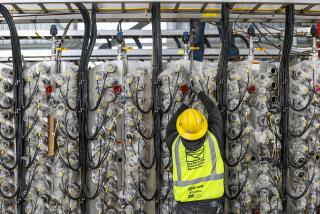U.S. Proposes $40 Million for Rockwell Cleanup Plan
- Share via
The Department of Energy’s five-year blueprint for cleanup of federal energy research and weapons sites includes about $40 million for decontamination and environmental testing at Rockwell International’s Santa Susana Field Laboratory west of Chatsworth and its De Soto Avenue plant in Canoga Park, according to documents obtained from the DOE in Washington, D.C.
The draft proposal includes more than 20 specific projects for the local plants during the next five years, ranging from improved chemical storage and ground-water testing to cleanup of old nuclear reactor buildings and tainted soil. Since the 1950s, both Santa Susana and the De Soto plant have done nuclear research for the DOE and its predecessor, the Atomic Energy Commission.
Although the draft report, recommending $19.5 billion for the first phase of cleanup of federal energy sites nationwide, was ordered released Tuesday by Energy Secretary James Watkins, DOE officials in Washington and San Francisco said they still did not know exactly how much money had been earmarked for the Rockwell sites. The $40-million estimate was derived from a review of dozens of individual data sheets, spelling out funding levels for specific cleanup projects.
Final Version
Dick Nolan, special assistant to the manager of DOE’s San Francisco operations office, said Wednesday he believed the total proposed for the local plants was “in the high 30s”, but that he wasn’t sure. He said a final version of the plan is scheduled for release in three weeks.
Officials with Rockwell’s Rocketdyne division, which operates the Santa Susana and De Soto plants, said late Wednesday they hadn’t seen the plan and couldn’t comment.
But Nolan called the five-year plan “a living document” that will be periodically updated to reflect newly discovered cleanup needs and priorities. Some pollution problems, such as chemically tainted ground water, could take much longer than five years to correct.
Once the plan is made final, it will still depend on funding by Congress.
Despite extensive cleanup needs, officials of Rockwell and the DOE have repeatedly said Santa Susana poses no immediate health hazard. The federal Environmental Protection Agency has endorsed that position in a qualified way, noting that more monitoring of air and ground water is needed to make sure the lab is safe.
Most of the cleanup projects--including the big-ticket items--are at Santa Susana, which includes DOE’s Energy Technology Engineering Center, where Rockwell does research with non-nuclear components of atomic power plants. From the mid-1950s through the early ‘80s, 15 nuclear reactors also were operated at Santa Susana for the federal government, and contamination remains despite several decommissioning projects.
The proposal calls for spending $7.1 million over four years to decontaminate Santa Susana’s Building 59, where contaminated steel, sand and ground water were left after shutdown of a test nuclear reactor. Rocketdyne officials said some of the work has been done. Another $4.4 million is recommended for cleanup of former reactor test areas in Building 24.
Sodium Burn Pit
The proposal includes $2.27 million for decontamination of soil, buildings and a leach field at a complex called the radioactive materials disposal facility, and more than $6.4 million to clean up chemical and radioactive contamination at a disposal site known as the sodium burn pit.
The draft plan calls for spending as much as $5.2 million to decontaminate the “hot cell” at the lab in the Simi Hills.
The hot cell is a heavily shielded structure used to declad, or take apart, intensely radioactive nuclear fuel. This is done to remove plutonium and other materials for future use at other government sites. Rocketdyne’s last fuel decladding contract with the DOE ran out in 1986. But the company has said it hopes to get future work and has applied for renewal of its hot cell license with the NRC, a request being opposed by some local groups.
Rockwell officials said Wednesday that inclusion of the hot cell cleanup project did not mean they had given up hopes of doing nuclear fuel work in the future.
DOE and Rockwell officials were unable to fully explain a proposed $177,000 for disposal of plutonium and other radioactive waste from two pending lab experiments. One of the experiments would involve “disposal of depleted uranium waste from a DOE/Rocky Flats explosion forming process,” according to one of the data sheets.
Metals Not Explosive
Bob Tuttle, radiation and nuclear safety manager for Rocketdyne, said he did not understand that description of the work, which involved a process developed at Rocky Flats, the problem-plagued nuclear weapons plant near Denver run by Rockwell for the DOE. He said the radioactive metals used in the experiment were not explosive.
The largest of the De Soto projects is a proposed $500,000 program to monitor ground water beginning next year for chemical and radioactive pollution. State water officials, saying they had not been aware of the extent of nuclear work at De Soto, asked for the testing several weeks ago. Rockwell officials said they do not expect to find any radioactivity.
The De Soto plant operated a small nuclear reactor from 1959, when it opened, until 1978. The plant also manufactured nuclear fuel for the Atomic Energy Commission and its successor, the DOE, from 1959 until 1982. Decontamination of the 100,000-square-foot fuel fabrication area in 1984 involved removal of some soil where radioactive water had leaked through pipe joints.
Rockwell still operates a gamma irradiation cell at De Soto, and the draft DOE plan called for spending $123,000 to decommission it by 1995.
Times staff writer Alan C. Miller contributed to this story.
More to Read
Sign up for Essential California
The most important California stories and recommendations in your inbox every morning.
You may occasionally receive promotional content from the Los Angeles Times.













